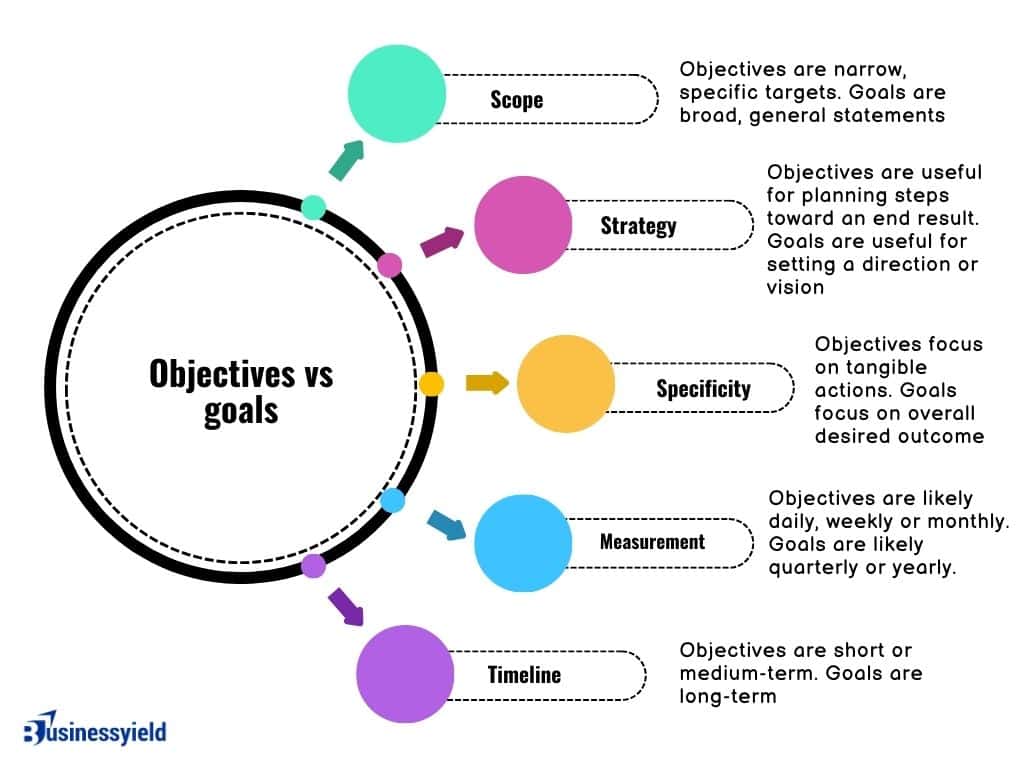Goals and objectives are essential, not just to being a successful leader, but to excel at anything in life. But what is the difference between objectives vs goals? To put it simply, objectives are short-term and measurable targets you set for yourself and your business. Goals, on the other hand, are typically long-term, overarching ideas concerning what you want for your business.
Although the terms “goals” and “objectives” both refer to the desired outcomes that a person or business wants to achieve, it is important to understand the significant difference between them. Setting and using clear objectives and defined goals are strategies you can use to increase the success of your company or advance your career.
Key takeaways
A goal is an achievable outcome that is typically broad and long-term.
An objective defines the specific, measurable actions each team employee must take to achieve the overall goal.
The main difference between a goal and an objective is that goals provide direction whereas objectives measure how you should follow that direction.
While goals and objectives are two different concepts, they work together to help you maximize your team’s productivity and achieve excellent results.
Objectives vs goals: What are objectives?
Objectives are specific, actionable targets that need to be achieved within a smaller time frame, such as a year or less, to reach a certain goal. They describe the actions or activities involved in achieving a goal.
Below are some examples of objectives:
- Earn a minimum of 15% return on investment in a fiscal year
- Increase the company’s market share to 7% by the end of the next fiscal year
- Cut down the operating costs by 10% within two years
- Reduce the response time for sales inquiries to 12 hours by the end of this quarter
Your objectives describe a series of tasks and activities that, if completed, enable you to achieve an aim. Objectives not only map directly onto an aim but also have a start and end date.
Note: Some businesses set and measure objectives through frameworks like Objectives and Key Results (OKR) and Key Performance Indicators (KPI).
Objectives vs goals: Types of objectives
There are three major types of objectives: strategic, tactical, and operational objectives. They are all different but each of them plays a pivotal role in achieving larger goals. Let’s see how each type fits into a business setting.
Strategic objectives
Strategic objectives are high-level, long-term objectives that help teams achieve the overall goals of a business. These objectives ensure that team members clearly understand what they’re supposed to do to get the business closer to where you want it to be.
An organization’s C-suite usually outlines strategic objectives at the start of the year and reviews them every quarter. It is only after they set strategic objectives that they set any other type of objectives.
Example: Growing gross revenue to $3m by 31st December 2024. This is a broad objective set by the leadership of a business. It’s left for the teams that constitute the business to set shorter-term objectives to reach this target.
Tactical objectives
To grow a business, teams have to break down each strategic objective the company sets into smaller, more actionable elements. These elements are tactical objectives.
Tactical objectives focus on using the results of short-term tasks and long-term goals to inform business decisions. This type of objective is most commonly used by teams working on complicated projects with numerous short-term deliverables.
Example: Attracting 3 major clients from the Asia Pacific region by the second quarter. This is a tactical objective because the sales team is solely responsible for it.
Operational objectives
Operational objectives are short-term, action-oriented goals that organizations set in a bid to partially accomplish broader, long-term goals. These objectives comprise specific daily, weekly, and/or monthly tasks that teams have to executive to contribute positively to bigger business objectives (or strategic objectives).
For instance, if your goal is to get three new business partners or investors, the immediate operational objective would be to craft a business proposal for each of your prospects.
How to plan an objective
Benefits of planning objectives
Planning objectives for a business or individual offers the following major benefits:
- Objectives measure your progress. Objectives help in measuring progress made toward achieving large goals. If goals are not divided into objectives, they may seem unconquerable.
- Objectives offer a sense of achievement. Meeting objectives usually creates a sense of achievement and motivates you to work further toward reaching your ultimate goals.
- Objectives confirm your confidence in the strategy. Defining your objectives allows you to confirm that the overall goal strategy is formulated correctly and that you can be successful.
- Objectives help in making difficult decisions. If you are faced with a difficult situation and are unsure what to do, you can always refer to your objectives to make sure you are moving in the right direction.
- Objectives help you understand what your company expects from you. Managers can use objectives to set targets for their team and motivate them to work toward a common goal.
Objectives vs goals: What are goals?
A goal is a short statement of the desired outcome to be accomplished over a long time frame, usually three to five years. It is a broad statement that focuses on the desired results and does not describe the methods used to get the intended outcome.
Some common examples of business goals include the following:
- Maximizing profits
- Growing revenues
- Increasing efficiency
- Providing excellent customer service
- Becoming an industry leader
- Creating a brand
- Becoming carbon-neutral
Setting goals in life is essential. Otherwise, you aimlessly drift around, hoping for the best to happen. You can avoid that by using the SMART framework to help you think about and craft highly effective, achievable goals in a way that ensures you’ll recognize the moment you’ve achieved whatever goals you’ve set.
Objectives vs goals: Types of goals
There’s no one-size-fits-all procedure for setting goals. Companies have several metrics to measure—especially in marketing—so they should have different kinds of goals to choose from. Goals are communicated to the team during a goal-setting meeting.
There are three major types of goals: time-based, outcome-oriented, and process-oriented goals. Each of them is set up differently and leads to a different kind of end result. Here’s what each of them entails:
Time-based goals
Time-based goals are driven by target dates (or deadlines). These goals specify what your team or employees should accomplish within a certain timeframe. Time-based goals are great for helping both teams and individuals plan and execute pressing tasks. However, these goals could be short-term or long-term, depending on the needs of your business.
You can track these goals with note-taking software or spreadsheets.
Outcome-oriented goals
Instead of focusing on deadlines, outcome-oriented goals are focused on end results. They’re all about accomplishing the required tasks well, no matter how long it takes. The objectives of outcome-oriented goals provide more information on when the goal should be accomplished, but deadlines can be pushed back if necessary so that the business can achieve the desired income.
Outcome-oriented goals are mainly used for big-picture changes and business milestones like hiring or resource allocation.
Process-oriented goals
If your business is looking to set up new internal systems and workflows, use process-oriented goals. Instead of focusing on outcomes, process-oriented goals focus on the work itself and how teams accomplish different tasks. These goals and objectives aim to improve team efficiency by implementing the most effective processes and workflows possible.
Accompanying these goals are process-oriented objectives that guide employees in their day-to-day activities.
How to set goals
Pro tip: No matter the type of goal you set, make sure it’s SMART. SMART stands for Specific, Measurable, Achievable, Realistic, and Time-bound. It’s easier to work towards and achieve goals that meet these criteria.
Benefits of setting goals
Although goals do not describe the method to achieve them, they set the direction for your efforts. In a business scenario, goals should be set to align with the mission and vision of the company. For individuals, workplace goals should align with their ultimate career aspirations.
Setting clear and compelling goals offers the following benefits:
- Goals give direction to your efforts. Goals are like a destination. Unless you know your destination, you do not know what direction to move toward.
- Goals help you reach your full potential. Setting and working toward your goals can help you realize your full potential and capabilities. You might start believing in yourself more than ever before, making it easier and quicker to reach your defined goals than in a scenario with no goals defined.
- Goals help you set your priorities. While setting goals, you consider various accomplishments for your future and reflect on what achievements are more important to you. Once you have a clear idea about what is more important, and what is less important, it becomes easy to set your priorities. Then, you can focus all your efforts on achieving your goals and prevent yourself from wasting time on something that is not that important.
- Goals motivate you to act. Keeping your meaningful goals in mind motivates you to persevere. Instead of hoping to do something someday, you focus on your progress right away. The joy of achieving your goals motivates you to keep working, regardless of the difficulties involved.
- Goals increase your conviction in achievement. Defining your goals gives the conviction and confidence that the set goals are achievable. Successful people typically know where they are going and how long it would take them to reach their destination.
- Goals support decision-making. When you have set goals, there is no confusion as to the direction you need to move toward. Whenever you need to choose between two courses of action, you can choose one that takes you toward your goals. As a result, having your goals defined aids effective decision-making.
Objectives vs goals: Major differences

As mentioned above, the main difference between goals and objectives is that objectives are more specific targets and describe tangible actions to achieve a result. Goals, on the other hand, are broader in scope and help create vision and direction.
Here are some of the major differences between objectives and goals broken down:
1. Scope
Objectives are more specific than goals and usually refer to one particular process – like sales and marketing. For example, if we’re talking about sales and marketing objectives, then you could have process objectives like a 20% increase in the number of prospects in your sales funnel.
Goals are comparatively more general statements, so their scope can be broad. In some instances, they don’t even have to be limited to a team or project – the entire organization can even follow broad, outcome-oriented goals.
For example, if the final goal is just to earn more money, all the members of an organization can align their efforts to accomplish this goal.
2. Alignment and order
Goals are set to achieve the mission of an organization or individual, while objectives are set for the accomplishment of goals. Goals are thus higher in order than objectives.
3. Time frame
Effective objectives have a specific target that’s set around a short or medium time frame. For example, common short-term objectives can last as long as a financial quarter. Your team needs to rush to meet your objectives within this time frame.
An organization’s goals, however, have a longer time frame than objectives. For example, an ideal time frame for a Fortune 500 company’s goals is around three to five years, while schools and early learning institutes prefer to use annual goals.
4. Tangibility
Goals can be intangible and non-measurable, but objectives are defined in terms of tangible targets. For example, the goal to “provide excellent customer service” is intangible, but the objective to “reduce customer wait time to one minute” is tangible and helps in achieving the main goal.
5. Specificity
Business goals are the broad statement of what must be achieved in the long run. They don’t describe any methods of how to accomplish the end result. On the other hand, the job of objectives is to briefly describe the specific actions that need to be completed within a short time frame.
6. Language
The language used to describe goals is a lot more focused on conceptual thinking, whereas the language used in objectives is more on the actionable and creative side.
Aligning goals vs objectives
To ensure that your goals will actually be met, you must assign measurable objectives to them. And vice versa, you want to give your objectives clear meaning by assigning a broad goal to them. All in all, breaking down goals into measurable objectives makes the former easier and less overwhelming.
To keep your objectives specific, it’s recommended to use the S.M.A.R.T. goal-setting method. S.M.A.R.T. goals have to be:
- Specific
- Measurable
- Attainable
- Relevant
- Time-bound
A great thing about this approach is that it will work great for both individual and corporate goals. If you ever feel intimidated by putting a plan together to undertake a long-term goal, consider trying the S.M.A.R.T method. This way, you will break down your goals and assign responsibilities, making it easier for all stakeholders to contribute efficiently.
Objectives vs goals: In conclusion
A goal is an achievable outcome that is typically broad and long-term. A company might use goals to inform yearly strategies that each department will execute. An objective, on the other hand, defines the specific, measurable actions each team employee must take to achieve the overall goal.
To sum it up, the main difference between a goal and an objective is that goals provide direction whereas objectives measure how you should follow that direction.
While goals and objectives are two different concepts, they work together to help you maximize your team’s productivity and achieve excellent results. This is because both work in tandem to ensure the successful planning and execution of a project. Without objectives, your teams won’t be able to communicate effectively to achieve your goals. And without goals, there’ll be no direction for your objectives.
Recommended Articles
- Price Lining: What It Is and Strategies for Effective Implementation
- What the Challenger Sales Model Is and How to Use It for Better Outcome
- How to Get into Medical Sales With No Experience
- Formal Writing: “To Whom It May Concern” Letter Examples and Templates
- What Is Gross Sales? How to Calculate It, Examples, and Net Sales Comparison
- How to Message a Recruiter on LinkedIn: A Detailed Guide






